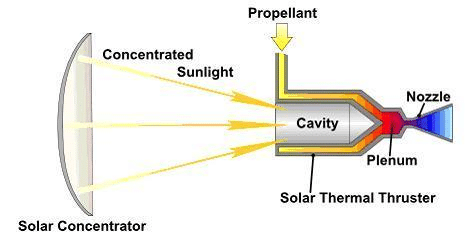Part 2 of 2 Parts (Please read Part 1 first)
Solar thermal propulsion has two particular areas of application. Earth-orbit transfers and scientific interplanetary missions.
The primary commercial application of solar thermal propulsion is the orbital transfer to larger communications satellites from low Earth orbit to geosynchronous Earth orbits. Multiple ignitions appear to be the best method for orbital transfer. This requires about twelve tons of liquid hydrogen which produces a specific impulse of seven hundred and fifty s.
The second main application of solar thermal propulsion will be for interplanetary missions. For these missions, large arcs of solar concentrators are needed to accurate focus sunlight on the absorber. The heat captured is then transferred directly to the propellant which creates a continuous thrust for the spacecraft. This method provides a much higher efficiency of conversion of sunlight to energy.
Conventional chemical rocket propulsion has been compared to solar thermal propulsion. A study on a Pluto flyby mission was carried out. It indicated that solar thermal propulsion could propel a larger payload than chemical propulsion with the same amount of fuel. This would reduce the ultimate cost of such missions.
Solar thermal propulsion is a promising new system for space travel. It has the potential to significantly reduce the launch sots of commercial satellites. Performance for interplanetary missions will also be raised. However, key technologies required by solar thermal propulsion will need to be developed before solar thermal propulsion is possible. These technologies include improvement in the heat capacity of heat exchangers, lightweight and rigid structures for the sunlight capture systems and the ability to store cryogenic hydrogen for long periods.
The absorber/receiver is the part of the system that absorbs and transfers the energy of the concentrated sunlight to the propellant. A heat exchanger is used to heat the propellant. The heat can be transferred continuously, or it can be accumulated and then transferred in a burst.
The performance of solar thermal propulsion lies between conventional chemical rocket propulsion and ion drive propulsion. Specific impulse is a measure of how efficiently a rocket uses a propellant. Seconds are the units used for specific impulse abbreviated as “s”. When employing indirect solar heating, a solar thermal system cannot produce a specific impulse of more than nine hundred s. This is due to some limitation on the temperatures that the heat exchanger material can withstand.
On the other hand, for direct solar heating, direct heat absorption allows higher propellant temperatures. It has a higher specific impulse of about twelve hundred s. Only indirect solar thermal heating has been experimentally tested. The United States Air Force Rocket Propulsion Laboratory used small-scale models to verify the limit of indirect solar thermal heating. Full sized prototypes have yet to be built but the models that have been tested so far show that the basic concept of solar thermal propulsion is sound.
At this time, the best use of solar thermal propulsion is in commercial satellites. Any future developments in this area are going to depend on the ultimate cost of this type of propulsion.
